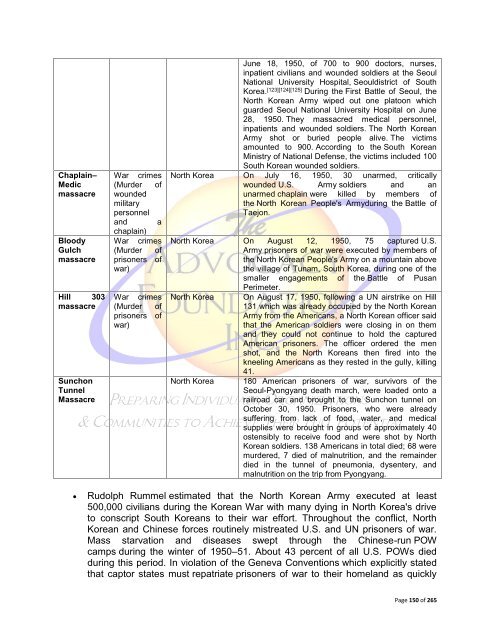The Law of War
The Law of War
The Law of War
Create successful ePaper yourself
Turn your PDF publications into a flip-book with our unique Google optimized e-Paper software.
Chaplain–<br />
Medic<br />
massacre<br />
Bloody<br />
Gulch<br />
massacre<br />
Hill 303<br />
massacre<br />
Sunchon<br />
Tunnel<br />
Massacre<br />
<strong>War</strong> crimes<br />
(Murder <strong>of</strong><br />
wounded<br />
military<br />
personnel<br />
and a<br />
chaplain)<br />
<strong>War</strong> crimes<br />
(Murder <strong>of</strong><br />
prisoners <strong>of</strong><br />
war)<br />
<strong>War</strong> crimes<br />
(Murder <strong>of</strong><br />
prisoners <strong>of</strong><br />
war)<br />
June 18, 1950, <strong>of</strong> 700 to 900 doctors, nurses,<br />
inpatient civilians and wounded soldiers at the Seoul<br />
National University Hospital, Seouldistrict <strong>of</strong> South<br />
Korea. [123][124][125] During the First Battle <strong>of</strong> Seoul, the<br />
North Korean Army wiped out one platoon which<br />
guarded Seoul National University Hospital on June<br />
28, 1950. <strong>The</strong>y massacred medical personnel,<br />
inpatients and wounded soldiers. <strong>The</strong> North Korean<br />
Army shot or buried people alive. <strong>The</strong> victims<br />
amounted to 900. According to the South Korean<br />
Ministry <strong>of</strong> National Defense, the victims included 100<br />
South Korean wounded soldiers.<br />
North Korea On July 16, 1950, 30 unarmed, critically<br />
wounded U.S. Army soldiers and an<br />
unarmed chaplain were killed by members <strong>of</strong><br />
the North Korean People's Armyduring the Battle <strong>of</strong><br />
Taejon.<br />
North Korea On August 12, 1950, 75 captured U.S.<br />
Army prisoners <strong>of</strong> war were executed by members <strong>of</strong><br />
the North Korean People's Army on a mountain above<br />
the village <strong>of</strong> Tunam, South Korea, during one <strong>of</strong> the<br />
smaller engagements <strong>of</strong> the Battle <strong>of</strong> Pusan<br />
Perimeter.<br />
North Korea On August 17, 1950, following a UN airstrike on Hill<br />
131 which was already occupied by the North Korean<br />
Army from the Americans, a North Korean <strong>of</strong>ficer said<br />
that the American soldiers were closing in on them<br />
and they could not continue to hold the captured<br />
American prisoners. <strong>The</strong> <strong>of</strong>ficer ordered the men<br />
shot, and the North Koreans then fired into the<br />
kneeling Americans as they rested in the gully, killing<br />
41.<br />
North Korea 180 American prisoners <strong>of</strong> war, survivors <strong>of</strong> the<br />
Seoul-Pyongyang death march, were loaded onto a<br />
railroad car and brought to the Sunchon tunnel on<br />
October 30, 1950. Prisoners, who were already<br />
suffering from lack <strong>of</strong> food, water, and medical<br />
supplies were brought in groups <strong>of</strong> approximately 40<br />
ostensibly to receive food and were shot by North<br />
Korean soldiers. 138 Americans in total died; 68 were<br />
murdered, 7 died <strong>of</strong> malnutrition, and the remainder<br />
died in the tunnel <strong>of</strong> pneumonia, dysentery, and<br />
malnutrition on the trip from Pyongyang.<br />
<br />
Rudolph Rummel estimated that the North Korean Army executed at least<br />
500,000 civilians during the Korean <strong>War</strong> with many dying in North Korea's drive<br />
to conscript South Koreans to their war effort. Throughout the conflict, North<br />
Korean and Chinese forces routinely mistreated U.S. and UN prisoners <strong>of</strong> war.<br />
Mass starvation and diseases swept through the Chinese-run POW<br />
camps during the winter <strong>of</strong> 1950–51. About 43 percent <strong>of</strong> all U.S. POWs died<br />
during this period. In violation <strong>of</strong> the Geneva Conventions which explicitly stated<br />
that captor states must repatriate prisoners <strong>of</strong> war to their homeland as quickly<br />
Page 150 <strong>of</strong> 265

















